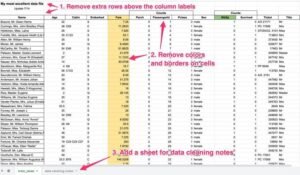Loading & Cleaning Data in Data Preparation & EDA
Data preparation is a foundational step in analytics. Before any meaningful analysis or visualization, the data must be properly loaded and cleaned. This ensures accuracy, consistency, and readiness for deeper exploration.
1. Importance of Data Loading and Cleaning
- Raw data is often messy, incomplete, and inconsistent.
- Loading and cleaning transforms this raw data into a structured and usable format.
- Proper preparation helps avoid errors, uncover insights, and ensure reliability in analysis and reporting.
2. Loading Data from Various Sources
- File-Based Sources: CSV, Excel, JSON, XML
- Databases: SQL Server, MySQL, Oracle, PostgreSQL
- Web & Cloud Services: Google Sheets, APIs, AWS, Azure
- In tools like Tableau, Power BI, Python (Pandas), or Excel, you can import data through user interfaces or code-based connections.

Key considerations while loading:
- Check data formats and encodings.
- Identify the delimiter (especially in CSVs).
- Handle large datasets with efficient loading methods.
3. Cleaning Data: Key Techniques
Once the data is loaded, cleaning is necessary to fix problems such as missing values, incorrect entries, and formatting issues.
Handling Missing Values:
- Options: Remove rows, fill with mean/median/mode, use forward-fill or backward-fill.
- Strategy depends on how critical the missing data is to the analysis.
Removing Duplicates:
- Identify duplicate rows or entries using keys or a combination of fields.
- Keep the most relevant row or average duplicates if needed.
Standardizing Formats:
- Ensure dates, numbers, and text fields are in consistent formats.
- Trim spaces, convert to lower/upper case, fix typos.
Data Type Correction:
- Ensure correct types (e.g., integer, float, datetime, string).
- Some tools auto-detect types, but manual correction may be needed.
Filtering Irrelevant Data:
- Remove outliers or irrelevant columns that don’t contribute to the objective.
- Create filters to narrow down the scope (e.g., only recent transactions).